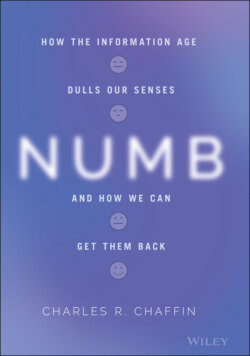Читать книгу Numb - Charles R. Chaffin - Страница 14
Technology and Our Attention
ОглавлениеThere is a relationship between technology and attention spans as well. In 2015, Microsoft examined the attention spans of hundreds of volunteers through both EEG scans (electroencephalogram, used to track and record brain waves) and survey data. Microsoft determined that the average attention span was approximately eight seconds, down from 12 seconds in 2000 (Perhaps more shocking, that eight‐second average is one second less than the average attention span of a goldfish). Subjects who had digital devices tended to have more difficulty in focusing their attention, particularly those who are constantly switching their attention between short activities. These short activities could be texting while responding to work emails as your attention is switched back and forth between two devices and two distinctly different topics. Many of these attributes are similar to those diagnosed with ADHD (attention deficit hyperactivity disorder), where individuals have difficulty focusing their attention for long periods of time.
The impact of regular distractions certainly adds up. A study from the University of California‐Irvine found that after an interruption, it takes on average 23 minutes and 15 seconds to get back on task in a natural work environment. That is, of course, assuming there are no further distractions during that 23 minutes. Those distractions do not just impact our work, but they also impact our focus on our relationships, reflection, and a myriad of other tasks that we perform in our daily lives. Nir Eyal, in his book Indistractable, outlines the internal and external triggers that can cause us to lose focus. Internal triggers are the urge to go onto social media or check if someone is texting us (you know, the three bubbles), or Google something just for the sake of googling it. External triggers are the push notifications that come from our smartphones, alerting us to everything from new tweets from the Kardashians to news and information from every app imaginable. We have become so focused on them that they are having an impact on almost every aspect of our daily lives. In fact, a recent study suggests that 10% of people check their smartphones during sex. I will resist the urge to opine on any impact on sexual productivity here, but the point is that we have a challenge when it comes to being focused in our daily lives.
Given that attention is both a vital and a finite resource, we have to take steps to ensure that we are allocating it towards the activities that are most important to us. First, we can actively manage the alerts on our smartphones. Do you really need all of those push notifications? If you cannot part with all of them, then maybe there can be a dedicated time when the smartphone can go into a drawer or even be turned off. At work, having your email open where push notifications alert you to every new email can also be a constant distraction. A dedicated time to focus on email can be a huge boost to productivity. And related, make commitments to complete tasks for a given period of time or even to completion. If you say, “I am going to work on this project for the next hour uninterrupted,” then create the environment to do so and get it done. Regardless of the strategy you employ, you are empowered to actively manage any distractions, whether internal or external, to your personal and professional life.
